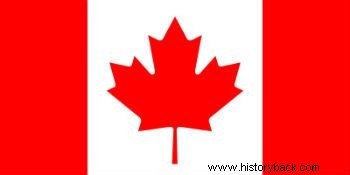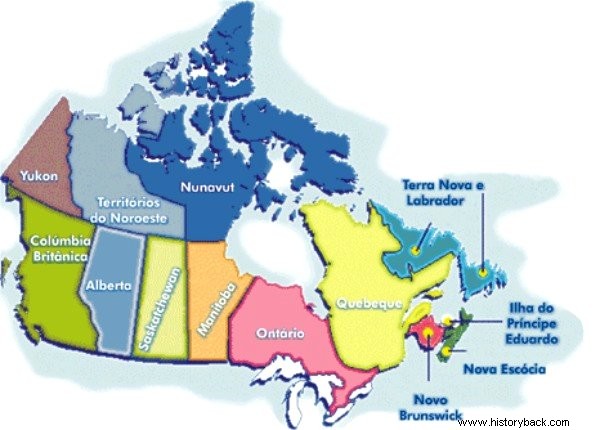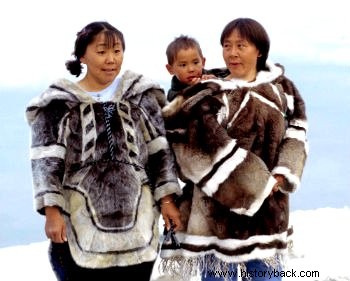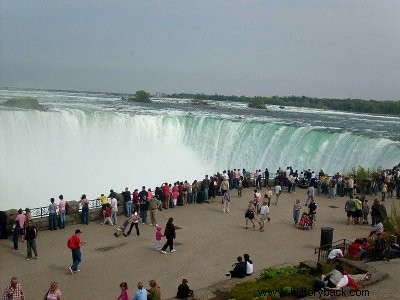The Canada is a country located in North America.
It is the second country in the world in territorial extension. It borders the United States to the south and northwest (Alaska) and the Atlantic Ocean to the north.
 The Canadian flag depicts a maple leaf, typical of the region
The Canadian flag depicts a maple leaf, typical of the region
General Data
- Official name:Canada
- Capital:Ottawa
- Territorial extent:9,900,610 km 2
- Inhabitants:35.8 million (World Bank, 2015)
- GDP (Gross Domestic Product):$1.5 trillion (World Bank, 2015)
- Weather:Seasoned with the four well-defined seasons
- Official languages:English and French
- Religion:More than 90% of the population is Christian. However, there is no official religion in the country.
- Currency:Canadian Dollar
- System of Government:Federal Constitutional Monarchy
- Major cities:Toronto, Montreal, Vancouver, Calgary, Ottawa and Edmonton
Territorial Division
 Map of Canada
Map of Canada
Canada is a federation made up of ten provinces and three territories. The provinces are:
- Alberta
- English Columbia
- Manitoba
- New Brunswick
- Newfoundland and Labrador
- Nova Scotia
- Ontario
- Prince Edward Island
- Quebec
- Saskatchewan
And the three territories:
- Yukon
- Nunavut
- Northeast Territory
The country is divided into seven regions:the Pacific Coast, the Cordillera, the Prairies, the Canadian Shield, the Great Lakes, the Appalachians, and the Arctic.
The country is bathed by the Atlantic, Arctic and Pacific oceans.
Culture of Canada

Members of the Inuit people
Canadian culture results from the mixture of English and French colonizers with indigenous people. The children of settlers with the indigenous Inuit people are called Métis.
This multicultural aspect is mainly perceived in the languages, as there are two official languages:French and English.
The native Inuit and other indigenous groups were not always treated well. Their territory was invaded and the populations confined in reservations.
Many had their children torn from their coexistence and interned in schools where they received a Western education so that any trace of their culture would be erased.
However, these policies have now been revised and Canada is considered one of the most receptive countries in the world. It maintains a policy of religious and cultural tolerance and seeks to maintain the tradition of ancestral peoples.
Canada attracted Asians who were employed as laborers in mines and railroads, starting in the 19th century and into the 20th century.
They are also part of the ethnic base of Canadians, Germans, Italians, Ukrainians, Poles, Dutch, Chinese, Portuguese and Scandinavians.
Immigration in Canada
The country has excellent quality of life indices. The Human Development Index is 0.967 (2016), the third in the world, and it has good schools and universities.
That's why, every year, it welcomes students from all over the world interested in studying English or French, doing an exchange program or studying for a degree.
Likewise, many Brazilians discovered that Canada has facilities to immigrate to other nations.
After all, the Canadian system is based on a points policy (where the level of education counts, for example), employability and family reunification.
Thus, there are very expressive Brazilian communities in cities like Toronto, Vancouver, Montreal and in the capital itself, Ottawa.
History of Canada
The Inuit Indians were the first inhabitants of the region that today corresponds to the territory of Canada and lived by hunting and fishing. Previously, the Inuit were called Eskimos, but this name is no longer accepted.
The French began exploring the territory shortly after Christopher Columbus arrived in America.
The expeditions of the navigator Jacques Cartier (1491-1557), who explored the São Lourenço River and made contact with the Iroquois Indians, made possible the French maritime expansion.
Cartier carried out two more expeditions to the territory maintaining contact with this tribe.
Subsequently, the first city to be founded in the territory was Quebec, in 1608, by Samuel Champlain.
There was an intense effort by France for the population of the region. The interest, however, came up against the difficult terrain, with practically inhospitable weather and harsh winters.
The natives, realizing that the French were here to stay, replaced the courtesy of the first voyages with open hostility.
Likewise, the British began to occupy that territory, taking advantage of the fact that they already had settlers installed in the 13 Colonies.
With that, disputes between the English and French began, always supported by indigenous tribes, who fought side by side with the whites.
The English conquest was consecrated after the Seven Years' War (1756-1763). Through the Treaty of Paris, the British took control of the region, but allowed the French colonists to retain their language and religion.
On July 1, 1867, three British provinces signed an act of independence from the United Kingdom and formed the Confederation of Canada.
It was only in 1931 that autonomy was extended, and in 1982 the country formally broke away from the British Parliament.
Currently, Canadian provinces have a lot of autonomy, but they have a federal government that coordinates them and maintains the British sovereign as head of state.
Geographical Aspects of Canada
Canada is as big as it is inhospitable. They have four well-defined seasons. Thus, the summer can register 35 ºC, while the winter 50 ºC negative.
The temperature fluctuation depends on the region. The climate limits the supply of arable land and there is little availability of crops in most of the territory.
The territory is bathed by numerous rivers and cut by several mountain ranges.
Canada's temperate climate varies with relief, precipitation and atmospheric pressure.
The more temperate area is found off the coast of British Columbia. In this region, the influence of hot and humid air currents leaving the Pacific is intense. Snow is rare in this region.
Warm, moist air that leaves the Pacific Ocean is trapped in the Cordillera area, which forms the Coast Range and the Rocky Mountains.
Unable to advance towards the plains, the humid air passes through the mountains, where it cools and falls in the form of rain.
The rain, however, is less in the valleys that are between the mountains and, therefore, there are summers with high temperatures.
On the prairies, winters are harsh and summers are quite hot. It is in this region that the chinook occurs. during the winter.
The chinook it is the winter wind that, because it is hot, causes temperatures to rise by up to 16 degrees in a day.
In the Great Lakes region, winter is accompanied by severe snowfall. The heaviest winters occur in the region called Atlantic Canada. In this area, the fog lasts until the summer, when the thermometers do not exceed 18 ºC.
Tourism in Canada
Canada's natural diversity invites tourists from all over the world. Winter attractions are the ones most sought after by visitors.
The country also has a great diversity of natural landscapes that enchant tourists. The Government of Canada maintains 38 national parks that correspond to 2% of the Canadian territory, as well as 836 historic sites, 1000 provincial parks and 50 territorial parks.
The places that most attract tourists are Vancouver and Toronto. Among the most exuberant attractions are Niagara Falls, located near the city of Bufallo, on the US border.
 Niagara Falls
Niagara Falls
Curiosities
- Canada has six time zones.
- Less than 1% of the world's population lives in the country.
- Canadian lakes hold 20% of all the world's fresh water.
- It is the country with the largest immigrant population in the world:1 in 5 Canadians was not born in Canada. Each year 300,000 new immigrants enter the country.
- Until 1982 all Canadian constitutional changes required the approval of the British authorities.
Read Also :
- Canada Flag
- North America
- Countries of North America
- Anglo Saxon America
- NAFTA
- APEC
- G20
- G7
- G8 - Group of Eight
- OAS - Organization of American States
